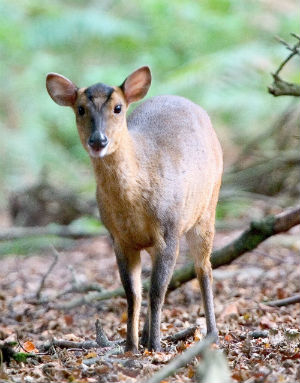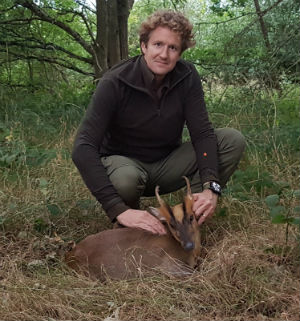With the Muntjac Buck's now clean of velvet, Peter Jones stumbles on a medal class buck whilst out with a client.

I called my colleague James ('the Badger', 'Motty') Mott, this week with the exciting news that we had shot what I suspected was to be a medal class Muntjac Buck.
(Above; Thomas with his first ever Muntjac, a superb once in a lifetime buck)
“I absolutely love Muntjac” were the first words out of his mouth and rightly so. It is a privilege to have this diminutive and often under valued deer on our grounds. Of course, much of the south east of England is now colonised by this Asiatic deer species, however their spread is still confined in the majority to the core counties of; Bedfordshire, Berkshire, Buckinghamshire, Cambridgeshire, Essex, Hertfordshire, Leicestershire, Norfolk, Northamptonshire, Oxfordshire, Suffolk, Warwickshire and Hampshire where this in particular beast was shot. That is a significant spread in just sixty odd years, since their initial release in Bedfordshire in the 1950’s and is down in part to this deer species unique ability to be able to breed throughout the year.
Due to the short breeding cycle and perhaps due to their being an invasive and non-native species, the deer act does not provide a closed season for Muntjac and so shooting of buck and doe can take place all year round.
 However, ironically, on this particular occasion, it was not in fact Muntjac that we were after. Having entered a small area of woodland thick with Bramble (the Muntjac’s preferred food of choice), it was in fact a Roebuck that we had our sights on, until frustratingly a slight shift in wind direction allowed the focus of our attention to slip away and vanish into the undergrowth.
However, ironically, on this particular occasion, it was not in fact Muntjac that we were after. Having entered a small area of woodland thick with Bramble (the Muntjac’s preferred food of choice), it was in fact a Roebuck that we had our sights on, until frustratingly a slight shift in wind direction allowed the focus of our attention to slip away and vanish into the undergrowth.
Some what discouraged by this initial set back, along with my client Thomas, who had only the previous week completed his ‘Proficient Deer Stalker Stage 1 course’ (PDS1), we set off up a well-used trail in search of new pastures, until there, a movement on the track ahead. A Muntjac Doe, not 40 yards ahead of us making her way down the track toward us. Head down and initially unaware of our presence, Thomas quickly had the Sako 85 on the sticks and me at his side offering a little guidance.
At County Deer Stalking, with moderate densities of Muntjac on our ground, we have adopted a management policy of leaving the Muntjac Does and so I trusted my instincts and hoped for a trailing Buck, as is often the case when the Does are fertile. We weren’t to be disappointed, as just a few paces behind the doe, also trotting down the track toward us, was a mature buck.
The next minute was a tense one, the buck was not yet properly visible and was approaching head on at a slower pace than the doe, which was fast closing the gap between us and at 30 yards, with myself and Tom stood right slap bang in the middle of the trail, her head was soon bobbing up and down as she sought to establish what this strange object was, that had appeared on her regular trail.
 Would the buck come on before she bolted? Well we know the answer. Come on he did, a few more feet was all that was required and with the animal now broadside, Tom squeezed off a shot on his first ever Muntjac, and what a first animal to take.
Would the buck come on before she bolted? Well we know the answer. Come on he did, a few more feet was all that was required and with the animal now broadside, Tom squeezed off a shot on his first ever Muntjac, and what a first animal to take.
A 150 grain bullet from a .308 is a large calibre for a deer of this size. I have seen them ‘run on’ with a well-placed shot on numerous occasions, but this was not to be the case with this one, which collapsed on the spot.
(Right: A superb Muntjac buck)
With the Doe having been so close, I had been unable to risk getting my Swarovski Bino’s to my face in order to establish just what we had, and with the naked eye it is near impossible to establish the size of antlers beyond a rough estimate, so upon approaching I was very pleased indeed to see that we had something special.
Now I am not one to get out a tape measure there and then and it was obvious that we had a large animal and so this head would have to be confirmed later that evening once the animal was back home.
As a rule of thumb, I reckon on regular, thick tines of around 10cm each side to ensure that a Buck is worth taking to an official measurer. So, with that said, once home and with tape measure finally in hand, it was with some delight that from coronet to tip our buck exhibited regular antlers of 12cm each side, with a 12cm spread and brow tines also of around 2cm in length, this one was surely to be medal class.
Huge congratulations to Tom for keeping his cool and for putting his recent PDS1 training into practice when the big moment arrived.
In Hampshire Muntjac Bucks are now appearing clean of velvet. If you’d like to stalk Muntjac with ‘County Deer Stalking’ then contact: 01403 790244 or email:
Alternatively to read more about Muntjac stalking follow this link: muntjac-deer-stalking



















